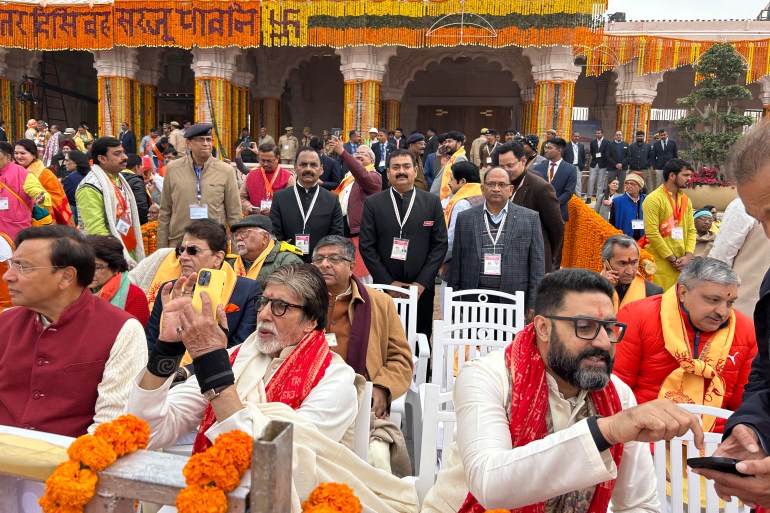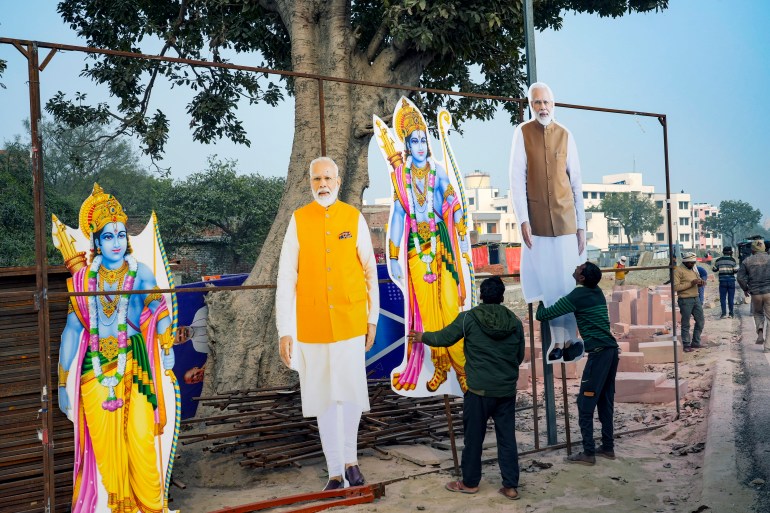
India’s Prime Minister Narendra Modi has opened a Hindu temple built on the ruins of a historic Mughal-era mosque in the northern city of Ayodhya.
The consecration of the temple dedicated to Lord Ram on Monday epitomizes the triumph of Modi’s muscular might Hindu nationalist politics and marks the unofficial start of his re-election campaign in general elections scheduled later this year.
Modi, wearing flowing gold-colored traditional attire, unveiled the black stone idol to the deity at the heart of the 50-meter (164-foot)-high temple in Ayodhya, nearly 700 km (435 miles) east of New Delhi.
The temple was built on the site where the Babri Mosque, named after the Mughal emperor Babar, stood for centuries before it was demolished by a Hindu mob in 1992.
The demolition of the 16th-century mosque sparked the worst religious unrest since independence – killing more than 2,000 people, most of them Muslims – and shook the foundations the officially secular political order of India.
Modi chanted Hindu religious verses on Monday before laying petals at the deity’s feet and folding his palms in prayer, then bowing before it and circling a holy flame as a military helicopter outside showered petals on the temple.
Traditional clarinets played devotional music during rituals for the 130cm (51-inch) black stone deity representing the God-King as politicians, businessmen, sports and film stars and millions of people across the country looked on.
“January 22, 2024 is not just a date in the calendar but heralds the beginning of a new era,” Modi said while addressing the temple after the consecration.

Most of India’s opposition parties, including the Indian National Congress, rejected the invitation to open the temple on the grounds that it did not suit a secular India.
But for Modi, the opening of the temple is a milestone in a decades-long campaign to align the country’s governance with his majority belief.
Around 80 percent of Hindus live in India, the most populous country in the world. India is also home to about 200 million Muslims, who have been frequently attacked by Hindu nationalists since Modi came to power in 2014.
The Legend of Ram
The temple is the sacred abode of Ram, one of the most popular gods of the Hindu pantheon.
Millions of Hindus worship Ram with the belief that chanting his name will bring peace and prosperity in difficult times, and most followers of Hinduism have Ram idols in their homes.
Major Hindu festivals such as Dussehra and Diwali are associated with mythological stories about Ram, extolling the virtues of truth, sacrifice and ethical governance.
The Hindu mythological epic Ramayan, which tells the story of Ram’s journey from prince to king, has been widely adapted in popular culture. One of the most watched legendary series is the television series Ramayan, which was created in the 1980s and still has a loyal audience today.
Ram’s divinity is not only the dominant religious force in India, but also part of the ancient cultural heritage in countries such as Thailand, Indonesia, Myanmar and Malaysia.

The Ayodhya dispute
Devout Hindus believe that Ram was born in Ayodhya more than 7,000 years ago, but the Babri Mosque was built over his birthplace by one of Babar’s generals. This brought the city into focus India’s Turbulent Politics and the Hindu majority’s desire to make amends for the country’s decades-long religious past.
In December 1949, authorities seized the mosque after members of a right-wing Hindu group placed Ram idols in the controversial building. Court orders prohibited the removal of the idols, and the structure’s use as a mosque virtually ceased.
Hindu and Muslim groups filed separate claims over the site and structure. In 1989, another court ordered the status quo to be maintained.
Hindu and Muslim groups tried unsuccessfully to resolve the dispute through talks before the BJP launched a nationwide campaign to build the temple in 1990.
Lal Krishna Advani, the then president of the party, embarked on a cross-country journey in a truck modeled on an ancient chariot. It ignited Hindu fervor, deepened the rift with Muslims, but also catapulted the party to national prominence.
The highlight of the BJP campaign was a rally in Ayodhya on December 6, 1992, when a mob scaled the mosque, smashed its domes with axes and hammers and leveled the entire structure. The event sparked sectarian riots in several parts of India, killing about 2,000 people, mostly Muslims.
As the party’s foot soldier at the time, Modi helped organize the chariot’s journey, which began in his home state of Gujarat. When he became prime minister in 2014 on a Hindu nationalist platform, it included, among other things, a promise to build the Ram Temple.
Hindus won a lengthy legal battle in 2019, allowing them to build the temple, while Muslims were allocated a plot of land miles from the destroyed Babri mosque to build a new building.
In 2020, Modi, the face of an unprecedented and uncompromising fusion of religion and politics in India, led the groundbreaking ceremony for the Ram Temple. But critics say the idea of a diverse, constitutionally secular state leading a Hindu religious ritual is unfortunate.






Recent Comments